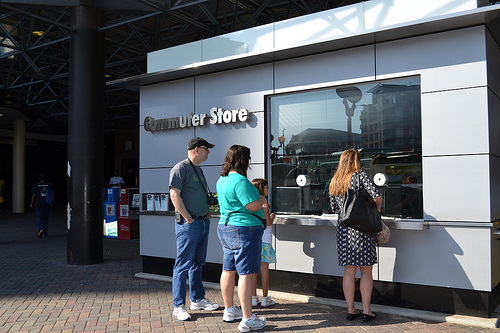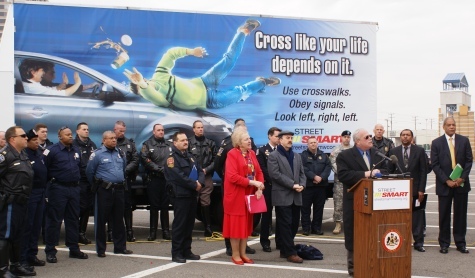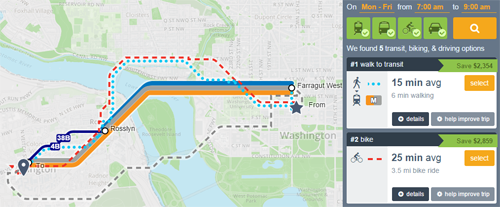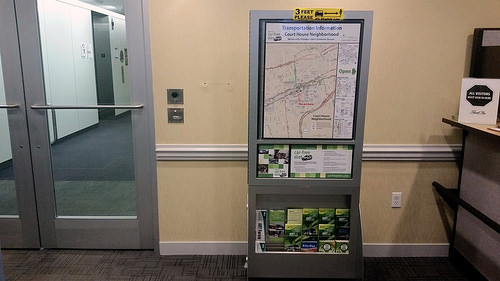10 steps to take 100,000 cars off DC’s roads
Want to reduce the number of cars driving around DC each day? The fastest way to do it may be a relatively cheap and non-controversial set of marketing and incentive programs, collectively called Transportation Demand Management (TDM).
TDM isn’t infrastructure. Rather, it’s a set of dedicated information, encouragement, and incentives that help people use existing infrastructure more easily and efficiently.
And boy, does it work.
For only about $10 million annually, Arlington’s robust TDM program converts about 42,000 car trips to alternative modes on Arlington’s roads every day. If DC had a similarly robust program, it might be even more successful. 100,000 cars a day would be a totally achievable goal.
DC already has a nascent TDM program called goDCgo. Right now goDCgo is too small to make much difference, but moveDC calls for a big expansion “based upon the model of Arlington.” Here are ten steps to actually get there:
1) Reach commuters through their employers
Nobody drives during rush hour because of a heartfelt love for congestion. Most people do it because that’s when their employer demands they arrive at work. Thus, employers have tremendous power over transportation. Leveraging that power can produce big results.
Rather than just offering free parking, employers can offer transit passes, Capital Bikeshare memberships, or any number of other things that would help their staffs to commute some way other than driving alone.
But business owners need hand-holding to know what sort of incentives work. That’s where a TDM staff team comes in. The TDM team works with businesses and property managers to set up a custom commuter benefit program for each one.
That’s the single most important part of a TDM program. In Arlington that team is called Arlington Transportation Partners (ATP). DC’s goDCgo employer services team should be double the size of Arlington’s, instead of a fraction of it.
2) Open transportation “genius bars”
Apple’s genius bars are the go-to spots for owners of Apple products who need tech support. The same model can work for transportation.
Research shows that even in the smartphone age, many people prefer to get information from live people. Arlington’s five Commuter Stores are one-stop shops that provide information and sell tickets for every transportation system in the region.
Put transportation stores in high traffic places like outside Metro station entrances, and let people talk about their commutes with an expert, face to face.
3) Teach people it’s OK to bike
About 60% of the population would be willing to bicycle, if it were easier and safer to do so. So teach them to make it easy and safe!
DC is doing well building new bike infrastructure, but that’s only half the answer. You also need to educate people about it and encourage them to use it, and that’s largely missing from DC’s TDM program. Bike Arlington staff attends major community events, offers confident city cycling classes, and uses social media to connect with people and get them on bikes more often.
4) Stop scaring people
It’s legitimately important to teach people how to share the road safely, but too many safety campaigns scare people away from walking or biking by making them seem more dangerous than they really are.
Safety campaigns should focus on teaching people how to do things right, rather than chiding them for what they do wrong. Arlington’s PAL campaign is a great example.
5) Treat marketing as equally important with infrastructure
Before anyone changes their commuting behavior, they must know alternatives exist, and must be confident those alternatives are reliable.
Marketing isn’t fluff. It’s the necessary grease that smooths the wheels of infrastructure. Every TDM program needs an umbrella marketing campaign that ties everything together, and gets the word out to travelers.
Arlington’s Car-Free Diet combines advertising, social media, street teams, events, and retail partners in order to get the word out about transit, biking, and everything else under the sun.
6) Make the internet and open data work for you
Smartphones and the internet are revolutionizing more than how we hail taxicabs. Invest in high-tech tools that make getting information easy, and open your data so third parties can make apps for you, for free.
Arlington’s Transit Tech Initiative fosters and helps produce websites like CarFreeAtoZ, a multimodal trip planner that’s prettier, includes more information, and is easier to use than single-agency trip planners like WMATA’s.
7) Do more than translate: Transcreate
We aren’t a monolithic people. Different groups perceive information in different ways. To reach them effectively, you can’t just translate the words of existing materials into multiple languages. Rather, materials need to be transcreated, so each audience gets the message in terms that will be most meaningful to them. ACCS has a Hispanic marketing unit that does this. So should goDCgo.
8) Follow through on good ideas with a strong ground game
Smartphones and apps are great, but lots of people still rely on paper. TDM agencies need strong distribution and logistics teams, to make sure everyone in town gets the message. Mail schedules and maps to individual homes, and use trucks to deliver “take-one” boxes directly to companies, hotels, and stores, for businesses to make available to their customers.
A dedicated logistics team lets others concentrate on what they do best.
9) Make transportation options part of the building code
Want to make buildings safe from fire? Design them with sprinklers and other safety features. Want to make it easy to drive? Incorporate a parking garage. Want to get people onto transit, bikes, and sidewalks? Embed convenient and attractive bus stops, bike infrastructure, and street entrances into your buildings.
Just like zoning specialists review new development for compliance with the zoning code, TDM specialists should review new development for transportation. Arlington’s TDM for site plan unit helps review new development, writes enforceable conditions into the approvals for new buildings, and follows up each year to ensure compliance.
10) Track progress with real data
Transportation agencies revolve around data, but it has to be good data. Historically they’ve focused on highway traffic counts, and have been slow to recognize changes. To get highway engineers thinking about pedestrians and bicyclists, gather objective data to show them how important those other modes really are.
A TDM research program measures the impacts of multimodal services in ways that go beyond counting cars. Arlington’s program has grown into a research and development think tank called Mobility Lab that generates reams of hard data, which officials use to make the case for everything from bike lanes to bus stops. If DC partnered with Arlington on Mobility Lab, the benefits would magnify.
DC’s paltry TDM program is a missed opportunity
Arlington ‘s ACCS spends $10 million annually on its base TDM program. That money converts 42,000 daily single-occupant car trips to transit, bike, walk, and shared rides. DC can and should have a program that’s even more effective.
But despite its much larger population and employment base, the District’s budget for TDM is less than 20% of Arlington’s. If Mayor Bowser ramped-up DC’s TDM budget to be commensurate with Arlington’s, it would be a totally realistic goal to get 100,000 car trips off the streets every day.
The Move DC Implementation Plan identifies nearly $2 billion in annual DC spending on capital investments in the coming years. Surely it’s worth spending $15 million of that each year to make it all work better.





